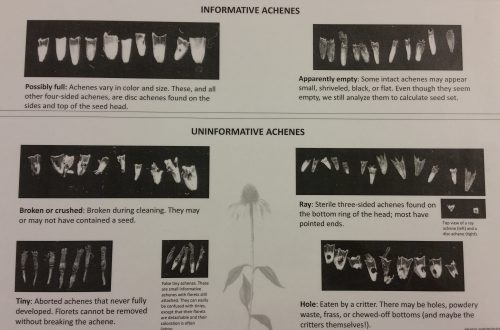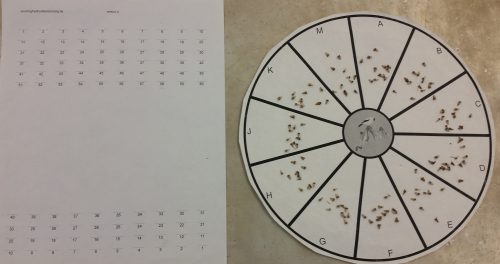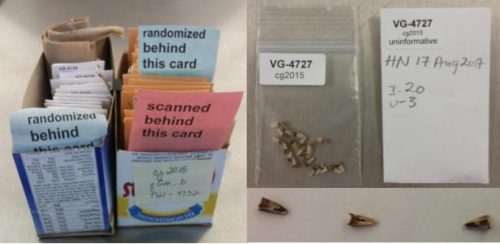The next step of the ACE protocol is to take a random sample of all the achenes which will then be x-rayed for seed set and viability. The randomness of the sampling is important to not introduce any potential biases in which achenes are chosen. If only potentially fertilized achenes were chosen then this would lead to bias in the data; thence, inaccuracy in assessing the experiments from which they came. The sampling of all the achenes will then be separated into informative and uninformative categories. The informative achenes will be x-rayed since they will be able to inform whether or not there is a viable embryo inside the achene. The uninformatives are those that have been damaged, eaten by a critter, or “tinies”/ “micros” that were never fertilized. There is a reference image to help determine whether achenes are informative or not (see image below).

General guide of how to identify the differences between informative and uninformative achenes
Detailed instructions of how to take a random sampling is in the protocols folder. The envelopes, segmented circle and achene counter paper is located in the cabinet to the right of the center area close to the windows.
The achenes to be used are in the box that has “scanned behind this card” present. The informative achenes get placed in the clear plastic baggies located in the drawer labelled “plastic baggies” make sure to use the “Good Ones” in the drawer. The uninformative achenes get placed in a small white envelope. Both get a label that corresponds to the original manila envelope from which it came. Spread the achenes evenly around a circle. Randomly select two segments to separate into informative and uninformative. These two segments account for about 1/6th of the total achenes. Record the number of informative and uninformative achenes from that envelope on a sheet (see image below). Once achenes from the manila envelope are sampled both the manila achene and chaff envelopes are placed behind a marker “randomized behind this card.”

Once the achenes are evenly distributed on the circle two segments are randomly selected and separated into informative and uninformative achenes
It can also be helpful to write this number on the white envelope. The white envelope and clear baggie containing 1/6th of the achenes are placed in another box. After this point the informative achenes will be x-rayed.

The next post will focus on what happens after the achenes have been scanned: COUNTING!

Leave a Reply